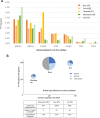Hereditary breast and ovarian cancer (HBOC): review of its molecular characteristics, screening, treatment, and prognosis
- PMID: 32862296
- PMCID: PMC8514387
- DOI: 10.1007/s12282-020-01148-2
Hereditary breast and ovarian cancer (HBOC): review of its molecular characteristics, screening, treatment, and prognosis
Abstract
Breast cancer is a common cancer affecting a large number of patients. Notably, 5-10% of all breast cancer patients are genetically predisposed to cancers. Although the most common breast cancer susceptibility genes are BRCA1 and BRCA2, which are also associated with the risk of developing ovarian and pancreatic cancer, advances in next-generation sequencing (NGS) analysis technology enabled the discovery of several non-BRCA genes responsible for breast and ovarian cancers. Studies on hereditary breast and ovarian cancer (HBOC) involve not only determining the predisposition to developing cancer, but also considering the current treatment for breast cancer, prevention of next cancer, risk diagnosis, and adoption of protective measures for relatives. We present a comprehensive review of HBOC, which will be a useful resource in the clinical setting. Many hereditary tumors, including HBOC, are syndromes characterized by the development of different types of cancer in succession. Taking advantage of knowing predisposition of susceptibility to cancer, it is important to continue and update cancer management protocols, which includes the adoption of preventive measures, countermeasures, and treatments, to accurately assess and prevent the impact of cancer on the quality of life of the next generation of patients.
Keywords: BRCA; BRCA1/2 mutations; HBOC; Hereditary breast and ovarian cancer.
© 2020. The Author(s).
Conflict of interest statement
The author declares no relevant conflict of interest with respect to the contents of this manuscript.
Figures




References
-
- https://gco.iarc.fr/. Accessed 7 Sept 2020
-
- National Cancer Institute Dictionary of Cancer Terms https://www.cancer.gov/publications/dictionaries/cancer-terms. Accessed 7 Sept 2020
Publication types
MeSH terms
Substances
LinkOut - more resources
Full Text Sources
Medical
Miscellaneous

